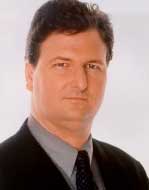Introducing Alex Lightman, Calit2 Scholar

Alex Lightman
Calit² Scholar
We are pleased to announce that Alex Lightman, entrepreneur and writer, has become the first Calit² Scholar. As part of his duties, he will contribute a series of articles analyzing technology trends, projecting what 10-15 years into the future might look like, and placing Calit² research projects and living laboratory activities in this context. This article is the kick off to what we expect will be one or two entries per week from Lightman.
Lightman comes to Calit² on the heels of publishing his first book, Brave New Unwired World: The Digital Big Bang and the Infinite Internet (Wiley, March 2002). This book, the first on fourth-generation (4G) wireless, covers 15 key technologies his research indicates are needed to make the next generation of broadband wireless Internet a technological and commercial success.
"I agree," says Lightman, "with what William Gibson, author of the novel Neuromancer, said: 'The future is already here, it's just not evenly distributed.' Like pieces of a broken magic object in a fantasy game, the elements of 4G are scattered across a number of different universities, laboratories, companies, and brains." Lightman considers Calit² one of the important laboratories.
His intention in writing BNUW was to send out a "sophisticated bird call" to attract a high-tech version of the fellowship of the ring that could pull together, analyze, modularize, and popularize the elements of 4G as they emerge from research labs.
According to Larry Smarr, Calit² director: "Lightman's book is one of the most comprehensive I've seen on topics directly relevant to Calit²'s mandate. So I'm very excited we've been able to entice someone with such a well informed perspective to write about Calit² research activities, placing them in the context of important future technology trends."
Lightman has received extensive media coverage as co-founder and CEO of Charmed Technologies, a company that specializes in wearable Internet technologies and products. Lightman's innovative philosophy extends to his role as producer of the company's wireless technology "fashion shows" that take place at Internet trade shows around the world. Charmed's customers include the V.A. hospital, the U.S. Navy, and a number of universities.
The company's vision is to incorporate the unwired Internet into fashion, lifestyle, and health applications by creating inexpensive, wireless, mobile devices that enable the wearers to have Internet access anywhere, anytime. This complements Calit²'s vision of extending the Internet throughout the physical world, and hence this collaboration was born.
Says Lightman, "I met Larry Smarr at a venture capital conference. He stood out because of his two big successes: creating the National Center for Supercomputing Applications, which later gave birth to NCSA Mosaic, which was to become the basis for the Web browsers we know and love. I dreamed of a front row seat to watch Larry create his own 'three-peat,' in this case an institute forming the foundation for what I anticipate will be a world-changing technological, economic, and social boom."
Described by Smarr as unusually energetic and creative, Lightman expects to publish periodic snapshots of what is happening at Calit², enabling readers to find information on topical areas, projects, and people of most relevance to their individual needs.
Lightman graduated from MIT in 1983. While there, he worked as an associate advisor to one of the co-founders of what became the MIT Media Lab (at the time it was called the Architecture Machine Group). He studied government funding for R&D, including creation of new industries, at Lund University, Sweden, and did graduate studies on comparative analysis of public policy in developing countries at the Kennedy School of Government, Harvard.
His first cover story was on computer graphics for The Futurist magazine in 1985. He has been an invited speaker at more than 250 conferences, including all 4G conferences, and a keynote speaker in more than 20 countries. He has published more than 50 articles, produced more than 50 virtual reality and other innovative Web sites, and produced more than 50 television segments on technology.
"As an author and speaker on the future of technology," says Lightman, "I see this collaboration as the professional opportunity of a lifetime, the chance to study something wonderful up close -- and almost from the beginning."
Please join us -- Calit² faculty, staff, and students -- in welcoming and supporting Lightman in this endeavor. Adds Lightman: "And please tell me what you think should be written about." Lightman can be reached at alex@charmed.com.

